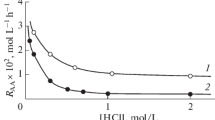Abstract
The epoxidation of methyl linoleate was examined using transition metal complexes as catalysts. With a catalytic amount of methyltrioxorhenium (4 mol%) and pyridine, methyl linoleate was completely epoxidized by aqueous H2O2 within 4 h. Longer reaction times (6 h) were needed with 1 mol% catalyst loading. Manganese tetraphenylporphyrin chloride was found to catalyze the partial epoxidation of methyl linoleate. A monoepoxidized species was obtained as the major product (63%) after 20 h.
Similar content being viewed by others
References
Lutz, J.T., Epoxidation, in Encyclopedia of Chemical Technology, edited by M. Grayson, John Wiley & Sons, New York, 1980, Vol. 9, pp. 251–266.
Findley, T.W., D. Swern, and J.T. Scanlan, Epoxidation of Unsaturated Fatty Materials with Peracetic Acid in Glacial Acetic Acid Solution, J. Am. Chem. Soc. 67:412–414 (1945).
Piazza, G.J., T.A. Foglia, and A. Nuñez, Optimizing Reaction Parameters for the Enzymatic Synthesis of Epoxidized Oleic Acid with Oat Seed Peroxygenase, J. Am. Oil Chem. Soc. 78:589–592 (2001).
Piazza, G.J., A. Nuñez, and T.A. Foglia, Epoxidation of Fatty Acids, Fatty Methyl Esters, and Alkenes by Immobilized Oat Seed Peroxygenase, J. Mol. Catal. B: Enzymatic 21:143–151 (2003).
Katsuki, T., and K.B. Sharpless, The First Practical Method for Asymmetric Epoxidation, J. Am. Chem. Soc. 102:5974–5976 (1980).
Meunier, B., General Overview on Oxidations Catalyzed by Metalloporphyrins, in Metalloporphyrin-Catalyzed Oxidations, edited by F. Montanari and L. Casella, Kluwer Academic, Dordrecht, The Netherlands, 1994, pp. 1–47.
Jacobsen, E.N., W. Zhang, A.R. Muci, J.R. Ecker, and L. Deng, Highly Enantioselective Epoxidation Catalysts Derived from 1,2-Diaminocyclohexane, J. Am. Chem. Soc. 113:7063–7064 (1991).
Herrmann, W.A., R.W. Fischer, and D.W. Marz, Multiple Bonds Between Main Group Elements and Transition Metals. 100. Part 2. Methyltrioxorhenium as Catalyst for Olefin Oxidation, Angew. Chem.Int. Ed. Engl. 30:1638–1641 (1991).
Adam, W., and C.M. Mitchell, Methyltrioxorhenium (VII)-Catalyzed Epoxidation of Alkenes with the Urea/Hydrogen Peroxide Adduct, 35:533–535 (1996).
Rudolph, J., K.L. Reddy, J.P. Chiang, and K.B. Sharpless, Highly Efficient Epoxidation of Olefins Using Aqueous H2O2 and Catalytic Methyltrioxorhenium/Pyridine: Pyridine-Mediated Ligand Acceleration, J. Am. Chem. Soc. 119:6189–6190 (1997).
Marks, D.W., and R.C. Larock, The Conjugation and Epoxidation of Fish Oil, J. Am. Oil Chem. Soc. 79:65–68 (2002).
Gerbase, A.E., J.R. Gregório, M. Martinelli, M.C. Brazil, and A.N.F. Mendes, Epoxidation of Soybean Oil by the Methyltrioxorhenium-CH2Cl2/H2O2 Catalytic System, 79:179–181 (2002).
Swern, D., Techniques of Separation E. Urea Complexes, in Fatty Acids Their Chemistry, Properties, Production, and Uses, Part 3, edited by S.K. Markley, Interscience Publishers, New York, 1964, pp. 2309–2358.
Ngan, F., and T. Ikesaki, Determination of Nine Acidic Herbicides in Water and Soil by Gas Chromatography Using an Electron-Capture Detector, J. Chromatogr. 537:385–395 (1991).
Hammond, E.G., Organization of Rapid Analysis of Lipids in Many Individual Plants, in New Series, Vol. 12, Modern Methods of Plant Analysis, Essential Oils and Waxes, edited by H.F. Linskens and J.F. Jackson, Springer, Berlin, 1991, pp. 321–330.
Samuelsson, J., and M. Johansson, A Study of Fatty Acid Methyl Esters with Epoxy or Alkyne Functionalities, J. Am. Oil Chem. Soc. 78:1191–1196 (2001).
Crombie, L., D.O. Morgan, and E.H. Smith, An Isotopic Study (2H and 18O) of the Enzymic Conversion of Linoleic Acid into Colneleic Acid with Carbon Chain Fracture: The Origin of Shorter Chain Aldehydes, J. Chem. Soc. Perkins Trans. 1, 3:567–575 (1991).
Herrmann, W.A., H. Ding, R.M. Kratzer, F.E. Kuhn, J.J. Haider, and R.W. Fischer, Multiple Bonds Between Transition Metals and Main-Group Elements Part 168. Methyltrioxorhenium/Lewis Base Catalysts in Olefin Epoxidation, J. Organometallic Chem. 549:319–322 (1997).
Capon, R.J., R.A. Barrow, S. Rochfert, M. Jobling, C. Skene, E. Lacey, J.H. Gill, T. Friedel, and D. Wadsworth, Marine Nematocides: Tetrahydrofurans from a Southern Australian Brown Alga, Notheia anomala, Tetrahedron 54:2227–2242 (1998).
Lie Ken Jie, M.S.F., and M.K. Pasha, Epoxidation Reactions of Unsaturated Fatty Esters with Potassium Peroxomonosulfate, Lipids 33:633–637 (1998).
Author information
Authors and Affiliations
Corresponding author
About this article
Cite this article
Du, G., Tekin, A., Hammond, E.G. et al. Catalytic epoxidation of methyl linoleate. J Amer Oil Chem Soc 81, 477–480 (2004). https://doi.org/10.1007/s11746-004-0926-3
Received:
Accepted:
Issue Date:
DOI: https://doi.org/10.1007/s11746-004-0926-3




